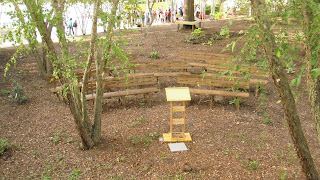This marks the fifth year for the meeting. Educators representing a wide variety of nonprofit and city, county, state and federal agencies and facilities, including, nature centers, science museums, gardens, arboretums, aquariums, state parks, the N.C. Forest Service, the Wildlife Resources Commission and Soil and Water Conservation Districts attended. The participants shared ways they can improve standards-based program offerings for schools and partner more effectively with teachers, school administrators and the Department of Public Instruction. “North Carolina has a unique partnership that encourages collaboration between schools, school districts, NC DPI and the nonformal education community to support science learning and environmental literacy,” said Debra Hall, elementary science consultant for the Department of Public Instruction.
The meeting provides an opportunity for educators to get updates on curriculum standards for NC DPI and instructs them on how to access support documents and resources to help them align their educational programs and field trips with the state’s essential standards for science. Participants heard from several guests speakers, including Renee Strnad with Extension Forestry at North Carolina State University who gave an overview of the North American Association’s Guidelines for Excellence in Environmental Education. These guidelines set professional standards for environmental literacy and work in concert with both national and state level educational standards.
Chris Goforth, the head of citizen science with the N.C. Museum of Natural Sciences, spoke to the group on how citizen science can be used to engage classroom teachers and students in authentic science experiences. Tom Randolph, lead interpretation and education ranger with Mt. Jefferson State Natural Area, discussed best practices for curriculum-based programs and field trips emphasizing hands-on, outdoor experiences for students and their connection to better classroom performance.
The meeting was held on the same day that the new Elementary and Secondary Education Act was signed into law. The Every Student Succeeds Act includes language that supports environmental education and environmental literacy programs. The act also supports hands-on learning” and “field-based or service learning” to enhance understanding of STEM subjects which will provide additional opportunities for environmental science education programs. “North Carolina has one of the strongest nonformal environmental education communities in country and the inclusion of field-based environmental science support in the Every Student Succeeds Act will further enhance the already diverse and effective environmental science programming in our state,” said Lisa Tolley, program manager with the Department of Environmental Quality.






















